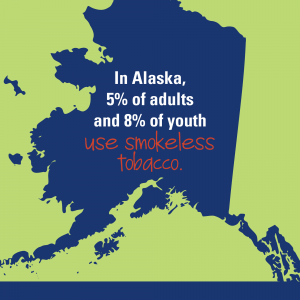Facts about smokeless tobacco
 Smokeless tobacco includes commercial products (chew, spit, snuff, snus, dissolvables, strips, sticks and
Smokeless tobacco includes commercial products (chew, spit, snuff, snus, dissolvables, strips, sticks and
orbs), as well as iqmik or blackbull. Males and females of all ages use smokeless tobacco. Smokeless
tobacco is NOT a safe or natural alternative to cigarettes. There are 28 known carcinogens in smokeless
tobacco as well as many health risks associated with its use.
Use of Smokeless Tobacco:
- The availability of nicotine in smokeless tobacco is more than twice that of cigarettes.
- The availability of nicotine in iqmik is more than double the amount of nicotine available in Copenhagen dipping tobacco.
- In Alaska, 5% of adults and 8% of youth use smokeless tobacco.
- 17% of Alaska Native women use smokeless tobacco during pregnancy.
- Among current smokers, smokeless tobacco use has increased slightly from 4% in 1996 to 5% in 2008.
- The use of smokeless tobacco varies by region; Alaskans in the Southwest Region are significantly more likely to use smokeless tobacco than those in any other region.
Health Effects of Smokeless Tobacco:
- Smokeless tobacco use increases the risk of developing cancer of the oral cavity.
- Smokeless tobacco use is strongly associated with leukoplakia a precancerous lesion of the soft tissue in the mouth.
- Smokeless tobacco use is associated with recession of the gums, gum disease and tooth decay.
- Smokeless tobacco use during pregnancy increases the risk for preeclampsia, a condition that may include high blood pressure, fluid retention, swelling, premature birth and low birth weight.
- Smokeless tobacco use by men causes reduced sperm count and abnormal sperm cells.
Tips to help you quit
Why Should I Quit?
- Even after smokeless tobacco is removed from the mouth, nicotine continues to be absorbed into the bloodstream. Nicotine stays in the blood longer for users of smokeless tobacco than for smokers.
- Smokeless tobacco causes a variety of cancers including oral cancer, esophageal cancer and pancreatic cancer.
- Using smokeless tobacco may also cause heart disease, tooth decay, gum disease and oral lesions.
- Five years after quitting tobacco your risk for cancer of the mouth, throat and esophagus are cut in half.
How Do I Quit?
- Call Alaska’s Tobacco Quit Line! The quit line is FREE for all Alaskans. Call 1-800-QUIT-NOW (1-800-784-8669) 24 hours a day, 7 days a week.
- Quit line services include phone coaching sessions and free nicotine replacement therapy.
- Get support from friends and family. Ask Alaska’s Tobacco Quit Line to send you the Ally Guide.
- Contact your healthcare provider to find the help you need to quit.
- Keep trying to quit! Most tobacco users make several quit attempts before staying quit for good.
